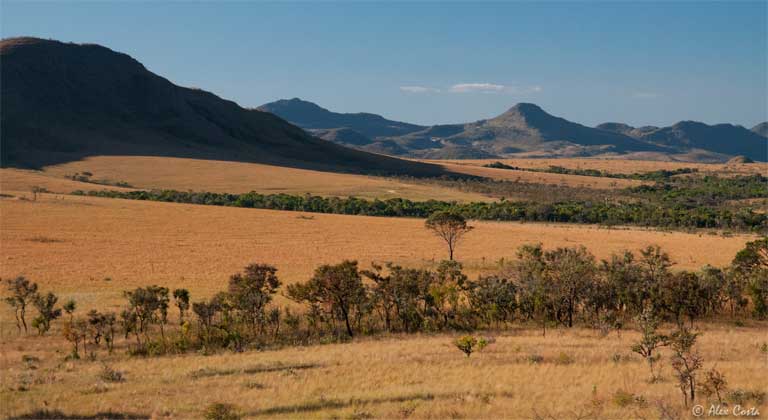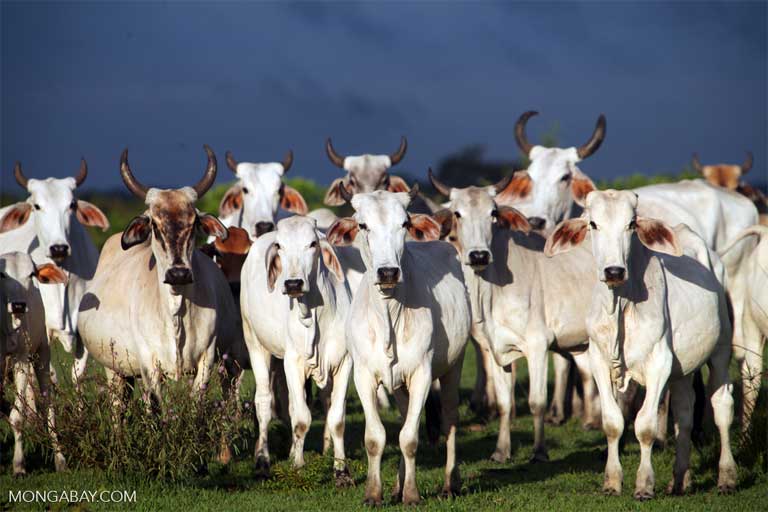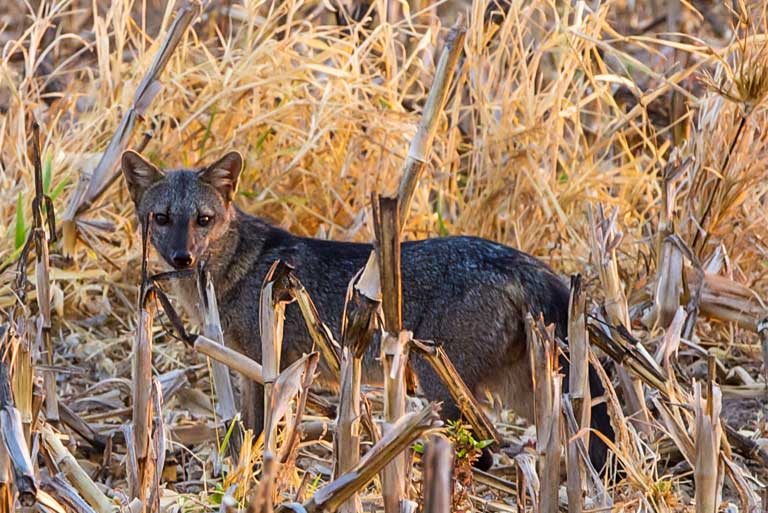- A new study has found that abandoned pasturelands in the Brazilian Cerrado do not regain their former biodiversity even after as much as 25 years. The Cerrado biome once covered 2 million square kilometers, but its rapid conversion by agribusiness means that less than half the region’s native vegetation remains.
- Researchers sampled 29 Cerrado pasture tracts that had been abandoned for between 3 and 25 years and found that native plants and animals largely didn’t return. Up to a quarter century after abandonment, restored savannas continued to lack 37 percent of their original species.
- Brazil’s Forest Code requires that at least 20 percent of private rural Cerrado property not be cultivated. However the new study suggests that the code may not be fully achieving its goal of protecting and restoring native species if the conserved land is degraded pasture, since native vegetation will not come back.
- The scientists suggest that one way of boosting biodiversity would be to use fire as a land management tool. Fire is a naturally occurring process in the Cerrado. Its artificial suppression allows trees to grow up, reducing biodiversity. So the reintroduction of fire could help restore native grasses as well as other species.

Once Cerrado savanna has been converted to pasture it does not fully regain its former flora and fauna, even after a quarter century, recent research has found. The Brazilian Cerrado biome, east and south of the Amazon biome, once covered 2 million square kilometers (772,204 square miles), but rapid conversion by agribusiness means less than half remains today. The region’s native vegetation and soils are important for storing carbon and curbing global warming.
The new study, published in the Journal of Applied Ecology sampled 29 Cerrado tracts which had previously been used for agricultural purposes, but had been abandoned for anywhere between 3 and 25 years. No matter how long since the land was last grazed, researchers found that native plants and animals that had lived there did not return.
“The big question of this research was, once land has been abandoned, can it actually be restored?” explained study co-author Giselda Durigan from the Forest Institute in Sao Paulo, Brazil. “We have shown that it’s basically impossible.”

The primary attributes of natural savanna biodiversity that remained absent from abandoned agricultural lands were native grasses, forbs and shrubs — extremely important habitat and food for a variety of native animals including birds, lizards, foxes, wolves, and deer. Up to 25 years after abandonment, restored savannas continued to lack 37 percent of their original species.
The researchers observed that of the 17 grass species recorded in natural savanna habitat, only three were to be found in abandoned pastures. Native grasses, which accounted for 23 percent of natural savanna land, were restricted to just 2 percent of the ground cover in abandoned pastures, and of the 29 abandoned pastures surveyed, 22 had no native grass cover at all.
Most of the abandoned agricultural tracts also contained invasive “exotic” grasses, primarily imported from Africa to Brazil in the 1970s; these species typically displace and replace native grasses because they are more competitive.
These results may not bode well for current Brazilian environmental policy: the primary reason pasture land in the study had been abandoned by landowners was to comply with Brazil’s key conservation law, the New Forest Code enacted by Congress in 2012 and upheld by the country’s Supreme Court in March. That code requires that at least 20 percent of all private rural property owned within the Cerrado not be used agriculturally, with the assumption that these abandoned pastures and croplands would revert fully over time to native vegetation.
The new study shows that this is not the case, even after a quarter century of abandonment, demonstrating that the code may not be achieving its intended habitat restoration goal.
“Even though restoration efforts do tend to comply with Brazilian law,” Derigan said, “the legislation doesn’t make any comments or restrictions about the quality of that vegetation.”
She explained that the most important finding of the research was that even though abandoned pasture does regenerate quite rapidly, it is still much poorer in terms of biological value and diversity, than what was originally found there.

The need for fire management
What makes the Cerrado, and other savannas around the world, uniquely important ecosystems is that they possess a diverse mosaic of flora and fauna, in a habitat characterized by sparse trees scattered across a continuous grassy ground cover.
If not curtailed by periodic fires, these savannas have a natural tendency to densify and become forests, thereby losing a lot of their original animal and plant life, according to the researchers. This low-diversity forest state is referred to as an “encroached forest,” and it tends to have around two fifths lower total ground cover, less than half the ground layer species richness, and about a twelfth of the native grass cover.
Using fire to reduce encroachment is therefore often an effective tool for retaining savanna biodiversity.
Researcher Derigan manages an ecological station in Sao Paulo, so has witnessed first hand how the absence of fire impoverishes savanna habitat. “I’ve clearly seen my station losing diversity in the thirty years I’ve been working here,” she said. “It was a mosaic and now many species of lizards, birds and mammals are simply disappearing; they are endemic to savannas and now there’s no habitat for them here.”
According to the researchers, the same dynamic applies to abandoned pastures. If fire doesn’t occur there, after around 49 years the land will naturally become a low-diversity forest, rather than a biodiversity rich, grassy shrubland. So, it seems logical that the controlled reintroduction of fire to abandoned agricultural lands could help them regain savanna biodiversity over time.

“Without fire, these abandoned lands become nothing more than a Cerradão [big Cerrado]” said Derigan, referring to savanna forest which is “poor in diversity of plants and animals.”
The researchers do, however, point out that if the aim of restoration is not greater biodiversity, but rather enhanced carbon sequestration (in order to either mitigate or defer global warming), or to rapidly regenerate soil cover, then “passive restoration,” avoiding the use of fire management, could be effective.
If the goal of restoration is recovery and maintenance of the natural savanna ecosystem, “active restoration” is necessary. This active restoration can vary in cost and effort, ranging from the removal of trees, to controlling exotic grasses and reintroducing native grasses and shrubs.
Derigan laid out a three-step approach to native savanna restoration in her interview with Mongabay:
“The first step is removing exotic grasses that were introduced from Africa; the second step is replacing those grasses with native ones; and the third, and more difficult, is to reintroduce fire as a management tool,” she said. “If we don’t burn these savannas every 3 or 4 years, they will become encroached savannas.”
Implementing this three-step process has its challenges: it requires reversing the long established mind-set of decision-makers to stop seeing fire as destructive, and instead conceptualize it as a useful tool for maintaining open savanna ecosystems in Brazil.
The historical use of fire for deforestation to create new pasture and croplands has generated a lasting perception that fire’s use is always ecologically damaging. This view, reinforced by the assumption that fire adds to the release of greenhouse gases and so to climate change, has helped lead to Brazil’s current policies of fire suppression.
On the contrary, Derigan and others argue, Cerrado ecosystems depend on a fire regime to maintain their structure and diversity.

The need to limit deforestation
The new research also clearly demonstrates the irreversible ecological impacts of deforestation and, as Derigan puts it, “shows that it is imperative that we stop converting the Cerrado” to soy, corn and cotton fields, and cattle grazing lands.
A more ecologically effective conservation approach would be to protect Cerrado tracts covered in native vegetation, while using already degraded lands for agricultural expansion. But this approach often runs up against the New Forest Code, since it doesn’t differentiate between native vegetation and degraded lands. So implementation would likely demand the code’s revision so as to be guided by the science.
“This paper is extremely important and timely,” said Lisa Rausch, a researcher from the University of Wisconsin who studies the impacts of agricultural expansion in the Cerrado. “These new findings – showing that regrowth on these abandoned pastures is likely to remain low in biodiversity in the absence of significant intervention – highlight the benefits of using such areas for soy expansion while saving remaining native vegetation.”
This conservation strategy wouldn’t only offer a win-win for Brazil: there are half a billion acres of degraded land across Latin America where small and large scale farmers, as well as commodities companies, could expand their enterprises without sacrificing native ecosystems.
Citation
Cava MGB, Pilon NAL, Ribeiro MC, Durigan G (2018). Abandoned pastures cannot spontaneously recover the attributes of old‐growth savannas. J Appl Ecol. 55(1164–1172). https://doi.org/10.1111/1365-2664.13046
Banner image: Cattle in Latin America. Rhett A. Butler/Mongabay

